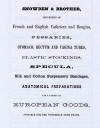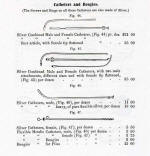Civil War Era Urinary
Catheters, Bogies, and Sounds
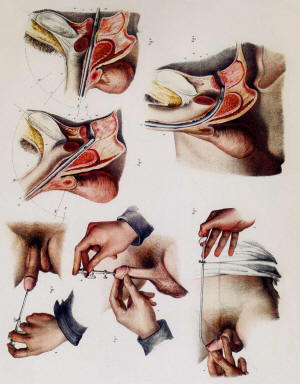 |
|
Drawings
from Bourgery & Jacob |
Catheters are used
to drain the bladder via the urinary tract. Sounds are used to
dilate the urinary tract which can be blocked due to infection,
prostate swelling, or trauma. The drawing to the left (click to
enlarge) shows various situations where a hollow catheter or
solid sound is inserted via the urethra. These tubes allow for
drainage of the bladder.
Various forms of
urinary tract catheters are shown in pre-Civil War catalogs by
Snowden & Brother and post-Civil War catalogs by Tiemann &
Co. and Gemrig. Frequently we find catheters are missing for
both pocket cases and full surgical cases. Why is anyone's
guess, but the empty formed spaces in a case are testimony to
their being missing.
Shown below are
pages from Snowden's pre-War catalog in 1860, Gemrig from the
1870's, and Tiemann's 1880's catalog. The metal catheters on
this page are silver and rigid, not flexible. This is the type
most often found in large Civil War era wood cased surgical sets
in the lower sections of the case, under the removable tray.
Also shown below are soft flexible catheters made in France and
sold by Tiemann and other makers.
There were no major
supplier catalogs published during the Civil War. The post-War
catalog evidence I have of this kind of urinary tract instrument
is from the late 1860's (Gemrig), and 70's, 80's Tiemann
catalogs, which may indicate advances in design during the War,
but most likely represents the same type of instruments used
during the Civil War.
Click on all images to
enlarge
Catheters shown in
Henry Smith's
1852 book on surgery
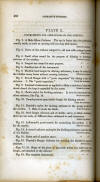
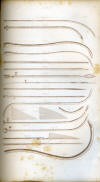
Catheters from
Snowden & Brother catalog, c. 1860
Snowden & Brother's
pre-War catalogue below shows they were importers of French gum
catheters
Catheters, sounds,
bogies, from Tiemann & Co. catalog, c. 1880's (examples at bottom
of page)
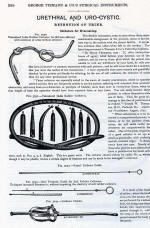
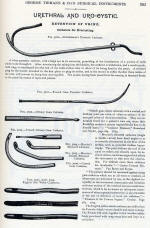
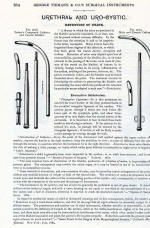
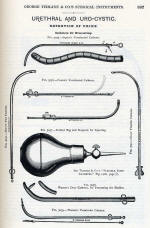
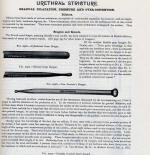
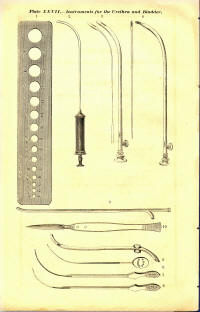
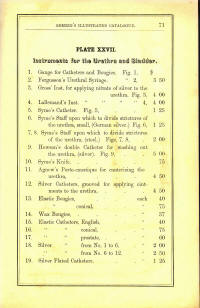
Catheters from
Gemrig's catalog c. late 1860's
Male catheters and
sounds from Civil War military field sets in this collection
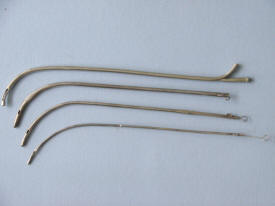
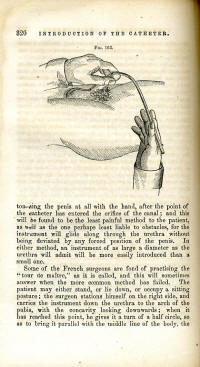
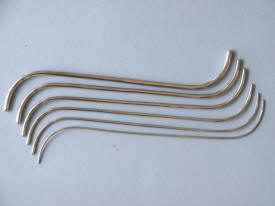
Catheters and sounds
from a
Tiemann Civil War field set
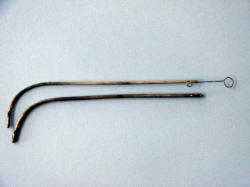
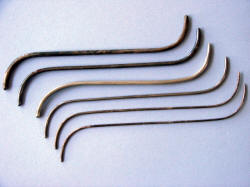
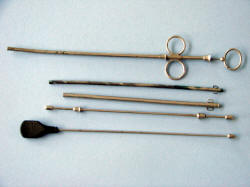
Catheters and sounds
from a
Tiemann Civil War military urology set
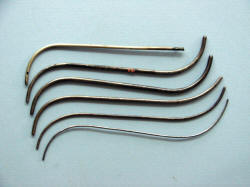
Catheter and sounds from
a
Snowden and Brother Civil War military set
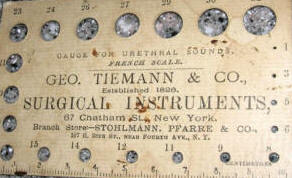
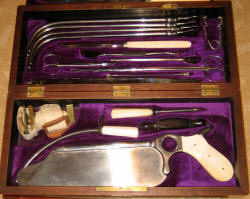
Above:
c. 1870 (67 Chatham) Tiemann ivory set with later
marked handled sounds (4 in top of photo) and (above
left) a Tiemann sounds gauge for determination of
the diameter of various sizes of sounds, like those
in the ivory set.
Below is a
collection of Geo. Tiemann catheters both hard and soft. Both
Snowden and Brother, as well as Tiemann imported French soft
catheters and those are included. Some of the soft catheters
have ivory tips. Some of these examples are exactly like those
described above in the Tiemann catalog.
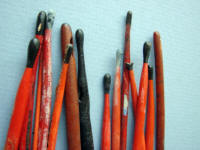
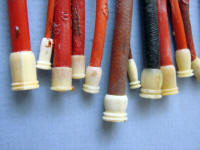
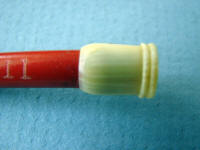
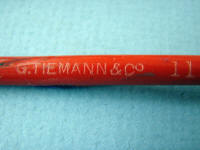
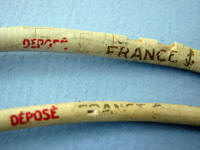
|
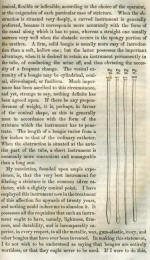 |
A page from
an 1851 book on urinary diseases by
S. Gross, M.D., which show similar gum catheters.
This
information is significant because we see use of gum
catheters during the Civil War, but most are no longer
in the sets because of use or over 125 years, they melt
and fuse together. |
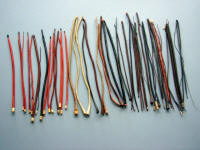 |
Rigid silver catheters
for draining the bladder after dilation with a urethral sound
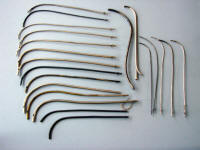
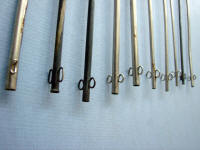
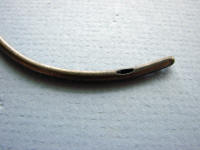
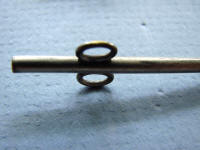
Silver catheters with
loops for attaching a string to hold them in place
Three examples of
catheter use reported during the Civil War from the History of
Surgical and Medical Records
Reasons for
rejection of Army applicants:
(32)
Incontinence of urine, being a disease frequently feigned and of
rare occurrence, is not of itself a cause for exemption. Stone
in the bladder, ascertained by the introduction of the metallic
catheter, is a positive disqualification.
Medical
cases cited in the Medical and Surgical History:
CAMPBELL, HARRISON G., Private of Co. F, 5th United States
Cavalry, aged 25 years, was wounded in action near Louisa Court
House, Virginia, on May 4th, 1863, and fell into the hands of
the enemy. He was exchanged, and sent to Annapolis on the
hospital transport State of Maine, and was admitted to the
general hospital at that place on May 17th, with two suppurating
sabre wounds of the scalp, one over the right parietal eminence,
the other behind the left ear. He had headache, with frequent
pulse, constipated bowels, and appeared to be very feeble. He
was purged, and then ordered good diets and." whiskey and
quinine freely." On May 20th erysipelas attacked the left leg,
which had received no injury. Tincture of iodine locally and
tincture of the sesquichloride of iron internally were employed
to combat this complication. On May 21st there was epistaxis;
the pulse was small, at 110; the tongue heavily coated. On the
23d there was diarrhoea, which was controlled by pills of opium
and camphor. The next day the pulse had risen to 120, and was
soft. The abdomen was tympanitic. Stimulants were freely given.
The catheter
was resorted to, on account of retention of urine, which was
scanty and high colored, and oil of turpentine, in doses of ten
drops, thrice daily, was ordered. On the 28th the erysipelatous
inflammation had extended up the back and over the right leg.
The teeth were covered with sores. Turpentine, with carbonate of
ammonia and whiskey and concentrated nutriment, and tincture of
iodine locally, constituted the treatment. On June 6th, the
erysipelas had extended to the face and throat, and the patient
became delirious. He continued in an unconscious state until
June 14th, 1863, when he died. Acting Assistant Surgeon J. M.
Matlock, who reports the case, ascribes the fatal event to
"exhaustion following typhoid erysipelas," and as unconnected
with the scalp wounds, which maintained an healthy appearance to
the last.
CASE.--Lieutenant Colonel Cornelius W. Tolles, chief
quartermaster Middle Military Division, was attacked on the 11th
of October, 1864, by a band of guerillas as he was passing
through Newtown, Virginia, on his way to the front. Although he
surrendered without resistance, one of the treacherous party,
stepping behind the Colonel, shot him in the head. The missile,
a pistol ball, penetrated the cranial cavity through the
occipital bone at a point midway between the superior angle and
the curved line, three-fourths of an inch to the left of the
median line, making a clean perforation and lodging in the
posterior lobe of the cerebrum one-half inch deep. He was
conveyed to Winchester, and placed under the care of Dr.
Emanuel, Acting Staff Surgeon U.S.A.
This
officer states that the wound suppurated well, and caused no
pain; the patient's mental faculties remained unimpaired, and
his appetite good, so that a favorable prognosis was granted. On
October 22d, the ball was extracted in small fragments. About
the end of October, evacuations of the faeces and urine began to
occur involuntarily; on the 31st, there was an entire
suppression of the urine, as ascertained by the introduction of
the catheter,
and the faeces were again discharged involuntarily. On the 4th
of November, the vision and hearing became defective. Delirium
ensued, and death occurred on November 7th, 1864. Upon removing
the calvaria, at the autopsy, the dura mater around the wound
was found ecchymosed, and the cavity in the cerebrum, which was
about one-half inch deep, filled with purulent and offensive
pus, and lined with plastic filamentous fibrin. A fragment of
bone, about three-fourths of an inch in diameter, was extracted
from a point just below. The pia mater had suffered morbid
changes. A sero-purulent fluid was found in the inferior and
posterior depressions of the lateral ventricles, and likewise in
the fourth ventricle, the lining membrane of which cavity had
undergone softening, as had also the sheaths of the roots of the
seventh, eighth, and ninth pairs of nerves, which were of a
greenish hue; the optic commissure was congested. The substance
of the encephalon was sound throughout. The semi-lunar lobe of
the left lateral hemisphere of the cerebellum was firmly
adherent to the tentorium. The case is reported by Acting
Assistant Surgeon W. L.
Hammond.
|
|



